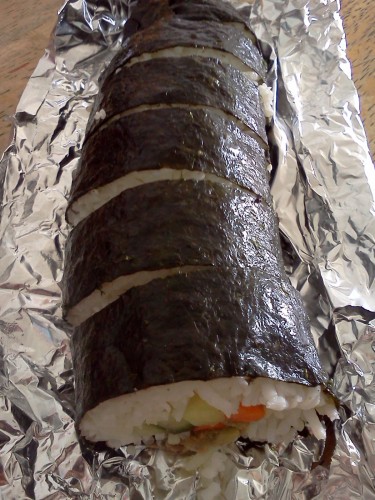I fell in love with kimbap when I lived in Seoul where I ate it every day for lunch. Since being gluten free it’s been impossible to find freshly made kimbap which is safe for me to eat. A couple of the traditional Korean ingredients are gluten-containing (imitation crab and processed ham) so I’ve altered the recipe a little to make it safe and gluten-free whilst still being delicious! It’s really hard to write down the process of making this but hopefully my directions are not completely incomprehensible and you’ll be able to make your own tasty kimbap!
Ingredients (makes about 6 kimbap)
- 6 Seaweed sheets
- 1.5-2 cups of rice (I use basmati rice because it’s my favourite but any rice will do, the stickier the better!)
- Can of tuna
- One large or a few small avocados
- Carrot (thinly sliced long ways)
- Cucumber (thinly sliced long ways)
- Gluten-free soy sauce and/or kimchi
How to make it (Prep)
- Rinse your rice then cook it!
- Meanwhile… Mix a can of tuna in a bowl with your avocados until it’s well mixed.
- Wash and chop your carrot and cucumber into strips.
- Take off heat, or turn rice cooker off, and leave rice to cool for a few minutes. I also like to rinse again afterwards although this can make it a little less sticky. I don’t add anything to my rice.
How to make it (Rolling time!)
I roll the sushi using my hands. If you find it easier, use a wooden sushi roller. The roller makes it more confusing for me but it’s personal preference.
- Lay a sheet of seaweed (make sure the shiniest side is face down) on some tin foil.
- Cover the seaweed with rice. Leave around 1cm at each edge and 2cm at the edge furthest from you. Ensure it’s evenly spread and there are no clumps.
- Spread tuna/avocado mix to the rice beginning at the edge closest to you. It’s not an exact science but I like to lay toppings around 1cm in to make rolling easier. Don’t leave much space at the left and right edges.
- Add carrot and cucumber on top of tuna/avocado mix. Again, ensure these reach both sides of the rice.
- To roll the kimbap, ensure the first roll you make completely covers your toppings then continue to roll until all the rice is covered and you have only the 2cm of free seaweed remaining.
- Dab a little water on the free seaweed and finish your final roll, pressing down a little to make it stick.
- To cut the roll, use a sharp knife and do it quickly to avoid it falling apart.
- Once cut, roll the kimbap up in the foil. This will help it to stay together and it’s great for refrigerating any rolls you don’t immediately devour.
- Repeat until all your seaweed, rice and toppings are done.
- Serve with kimchi or gluten-free soy sauce and enjoy!
